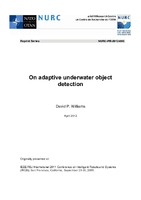| dc.contributor.author | Williams, David P. | |
| dc.date.accessioned | 2018-10-11T14:09:44Z | |
| dc.date.available | 2018-10-11T14:09:44Z | |
| dc.date.issued | 2012/04 | |
| dc.identifier | 42938 | |
| dc.identifier.govdoc | NURC-PR-2012-006 | |
| dc.identifier.uri | http://hdl.handle.net/20.500.12489/669 | |
| dc.description.abstract | A new algorithm for the detection of underwater objects in sonar imagery is proposed. One particularly novel component of the algorithm also detects the presence of, and estimates the orientation of, sand ripples. The overall algorithm is made extremely fast by employing a cascaded architecture and by exploiting integral-image representations. As a result, the method makes real-time detection of objects in streaming sonar data collected by an autonomous underwater vehicle (AUV) feasible. No training data is required because the proposed method is adaptively tailored to the environmental characteristics of the sensed data that is collected in situ. The flexible yet rigorous approach also addresses and overcomes five major limitations that plague the most popular detection algorithms that are in common use. Moreover, the proposed algorithm achieves superior performance across a variety of seabed types on a large, challenging data set of real sonar data collected at sea. Ways to exploit the findings and adapt AUV surveys for optimized detection performance are also suggested. | |
| dc.format | 11 p. : ill. (digital, PDF file) | |
| dc.language | English | |
| dc.publisher | NURC | |
| dc.source | In: Proceedings of the IEEE/RSJ International 2011 Conference on Intelligent Robots and Systems (IROS), San Francisco, California, September 25-30, 2011. | |
| dc.subject | Sonar images | |
| dc.subject | Image processing | |
| dc.subject | Seafloor ripples | |
| dc.subject | Target detection | |
| dc.subject | Algorithms | |
| dc.subject | Autonomous Underwater Vehicles (AUV) | |
| dc.title | On adaptive underwater object detection | |
| dc.type | Reprint (PR) | |
| dc.type | Papers and Articles | |
